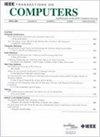Access-Pattern Hiding Search Over Encrypted Databases by Using Distributed Point Functions
IF 3.6
2区 计算机科学
Q2 COMPUTER SCIENCE, HARDWARE & ARCHITECTURE
引用次数: 0
Abstract
Encrypted databases have been extensively studied with the increasing concern of data privacy in cloud services. For practical efficiency, most encrypted database systems are built under Dynamic Searchable Symmetric Encryption (DSSE) schemes to support fast query and update over encrypted data. However, DSSE schemes allow leakages in their security frameworks, especially access-pattern leakages (i.e., the search results corresponding to queried keywords), which lead to various attacks to infer sensitive information of queries and databases. Existing oblivious-access techniques, such as Oblivious RAM and differential privacy, suffer from excessive communication overhead and loss of query accuracy. In this paper, we propose a new DSSE scheme that enables access-pattern hiding keyword search and update operations. Servers can obliviously query and update databases within only a single communication round. Our building block is based on the Distributed Point Function (DPF), an advanced secret sharing technique that provides provable security guarantees against adversaries with arbitrary background knowledge. Moreover, we devise a novel update protocol that integrates DPF and Somewhat Homomorphic Encryption (SHE) such that servers can obliviously update their local data. We formally analyze the security and implement the prototype. The comprehensive experimental results demonstrate the security and efficiency of our scheme.求助全文
约1分钟内获得全文
求助全文
来源期刊

IEEE Transactions on Computers
工程技术-工程:电子与电气
CiteScore
6.60
自引率
5.40%
发文量
199
审稿时长
6.0 months
期刊介绍:
The IEEE Transactions on Computers is a monthly publication with a wide distribution to researchers, developers, technical managers, and educators in the computer field. It publishes papers on research in areas of current interest to the readers. These areas include, but are not limited to, the following: a) computer organizations and architectures; b) operating systems, software systems, and communication protocols; c) real-time systems and embedded systems; d) digital devices, computer components, and interconnection networks; e) specification, design, prototyping, and testing methods and tools; f) performance, fault tolerance, reliability, security, and testability; g) case studies and experimental and theoretical evaluations; and h) new and important applications and trends.
 求助内容:
求助内容: 应助结果提醒方式:
应助结果提醒方式:


